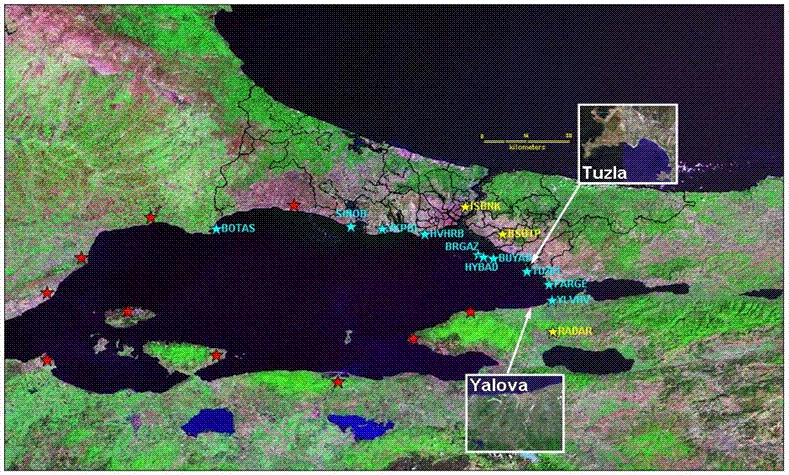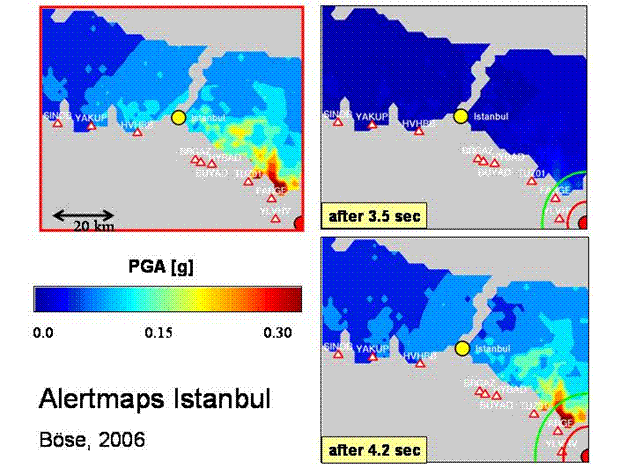General Objectives
The existing Early Warning System for Istanbul (Istanbul Earthquake Rapid Response and Early Warning System - IERREWS) will be expanded to regional scale (Marmara Region) and significantly improved in terms of quality of the warning information. Estimates of the degree of reliability will be delivered as well as real-time information on earthquake source parameters and near-real-time shakemaps for the region. As earthquake real-time information systems (ground motion prediction, source parameters, shakemaps, damage projection) are critical for rapid response in disaster management, we anticipate that the results of this work will not only be applied to Istanbul and the Marmara Region, but carry the potential of world-wide applications. This is the case because our algorithms will be set up in a way that they can be transferred and adapted to other regions.
Figure 3: Locations of currently used stations for earthquake early warning for Istanbul (blue stars) and new stations for expanding the system to the Marmara Sea area (red stars). Possible locations of the proposed downtown low-cost sensor test network (Part C of this proposal) are also shown.
Intended Achievements
Specific goals and products of this project are
A1. Expansion of real-time communication via satellite within the existing system to the Marmara Sea region. This step is crucial as the entire region is highly industrialized and densely populated.
A2. Optimization of the existing early warning system in terms of areal coverage and signal processing capacity. This is important as the current system operates with a very simple scheme that does not allow to fully utilize the seismological information and that does not include information on reliability of early warnings.
A3. Real-time evaluation of earthquake source parameters using Artificial Neural Networks.
A4. Establishment of best database of seismic events in the Marmara region.
A5. Expand current shakemap availability for the Istanbul area to the Marmara region.
A6. Provide reference data for testing the self-organizing sensor system developed in Part B of the consortium (Verbundantrag).
Items A1, A2, A3, A5 include software development with the potential of being applied world-wide in the future.
State-of-the-Art in Science and Technology
Substantial progress in seismic real-time acquisition and communication technologies, aside from enhancements of seismic processing software, has been made over the past few years. This paved the way for the design and implementation of earthquake early warning systems all over the world (Zschau and Küppers, 2003; Kanamori, 2005). Systems are now in operation in Japan, Taiwan, and Mexico (Nakamura, 1989; Wu and Teng, 2002; Espinosa-Aranda et al., 1995). In Romania and Turkey, systems have been constructed very recently (Wenzel and Marmureanu, 2006; Erdik et al., 2003). Earthquake early warning systems are effective tools for disaster mitigation if used for triggering and execution of automatisms to prepare vulnerable systems and dangerous processes for the imminent danger. Seismic warnings can be used to slow down high-speed trains to avoid derailments, to shutdown pipelines and gas lines to minimize fire hazards, to shutdown manufacturing operations to decrease potential damage to equipment, or to save vital computer information to inhibit losses of data. A compilation of effective measures in response to warnings is given by Goltz (2002).
One hundred strong motion accelerometers have been placed in populated areas of Istanbul, within an area of approximately 50 x 30 km, to constitute a network that will enable rapid shake map and damage assessment after a damaging earthquake. After triggered by an earthquake, each station will process the streaming strong motion to yield the spectral accelerations at specific periods and will send these parameters in the form of SMS messages to the main data center through available GSM network services. For earthquake early warning information, ten strong motion stations were located as close as possible to the Marmara Fault. The continuous on-line data from these stations will be used to provide near-real-time warning for emerging potentially disastrous earthquakes. Additionally 40 strong motion recorder units will be placed on critical engineering structures in addition to the already instrumented structures in Istanbul. All together, this network and its functions are called Istanbul Earthquake Rapid Response and Early Warning System (IERREWS). The system is designed and operated by Bogazici University with the logistical support of the Governorate of Istanbul, First Army Headquarters and Istanbul Metropolitan Municipality. Within the early warning part of the IERREWS, ten strong motion stations were located as close as possible to the Great Marmara Fault in on-line mode. Continuous telemetry of data between these stations and the main data center is realized by a digital spread spectrum radio modem system involving repeater stations selected in the region. Depending on the location of the earthquake (initiation of fault rupture) and the recipient facility, the alarm time can be as high as about 8 s. Thus Istanbul has a basic version of an early warning and rapid response system. However, this can be significantly improved with recent technologies.
Karlsruhe University (Geophysical Institute) has considerable experience in earthquake early warning systems. In April 2005, the Romanian Earthquake Early Warning System for Bucharest has been officially inaugurated by the Romanian Government with the National Institute of Earth Physics (NIEP) as operator. This system has been designed in cooperation (scientifically, technically and financially) between NIEP and Karlsruhe University in the frame of the Collaborative Research Center (Sonderforschungsbereich) 461: Strong Earthquakes – A Challenge for Geosciences and Civil Engineering (Wenzel et al., 1999; Wenzel et al., 2001; Wenzel and Marmureanu, 2006). In the same context we developed non-standard shakemap methodologies and risk estimates similar to HAZUS (Bartlakowski et al., 2006, Wenzel and Marmureanu, 2006, Wenzel and Marmureanu, 2007).
In cooperation with KOERI, a novel scheme for extracting early warning information from stations of the Istanbul Earthquake Rapid Response and Early Warning System (IERREWS) has been developed in the frame of a PhD thesis (Böse, 2006) jointly supervised by University of Karlsruhe (Prof. Friedemann Wenzel) and KOERI (Prof. Mustafa Erdik). Some of the results are published in Böse et al. (2005) and Böse et al. (2006), see also Fig. 4.
Figure 4 shows an example of an alert map for Istanbul in case of a M = 6.5 earthquake in the eastern part of the Marmara Fault. The left panel indicates the distribution of PGA after the earthquake: the right panels show the predicted alert maps after 3.5 and 4.2 seconds. After 4.2 seconds the map comes fairly close to the final ground motion, so that after this time the regional ground motion is fairly well predicted. The actual warning time for Istanbul for this earthquake is still 15.8 seconds.
The partners in KOERI developed the existing warning and information system, that includes installation of sensors, real-time communication, shakemap and earthquake loss estimation technology (Erdik et al., 2003a; Erdik et al., 2003b).
References
Böse, M., Erdik, M. and Wenzel, F., 2005: Earthquake Early Warning – Real-time prediction of ground motion from the first seconds of seismic recordings. Proc. Volume of the Int. Conference on 250th Anniversary of the 1755 Lisbon Earthquake, 185-187, 1-4 Nov. 2005.
Böse, M., Erdik, M. and F. Wenzel, 2006: A New Approach for Earthquake Early Warning. In: J. Zschau and P. Gasperini (eds.): Seismic Early Warning Systems, Springer Verlag, in press.
Böse, M., 2006: Earthquake Early Warning for Istanbul using Artificial Neural Networks. PhD thesis, University of Karlsruhe, Germany.
Erdik, M., Fahjan, Y., Özel, O., Alcik, H., Mert, A., Gul, M., 2003: Istanbul Earthquake Rapid Response and the Early Warning System. Bulletin of Earthquake Engineering, 1, 157-163.
Espinosa-Aranda, J., Jimenez, A., Ibarrola, G., Alcantar, F., Aguilar, A., Inostroza, M., and Maldonado, S., 1995: Mexico City Seismic Alert System. Seismological Research Letters, 66, 6, 42-53.
Goltz, J.D., 2002: Introducing earthquake early warning in California: A summary of social science and public policy issues,. Caltech Seismological Laboratory, Disaster Assistance Division, A report to OES and the Operational Areas.
Kanamori, H., 2005: Real-time seismology and earthquake damage mitigation. Annual Reviews of Earth and Planetary Sciences, 33, 5.1-5.20.
Nakamura, Y., 1989: Earthquake alarm system for Japan Railways. Japanese Railway Engineering, 8, 4, 3-7.
Wenzel, F., Oncescu, M.C., Baur, M., Fiedrich, F. and Ionescu, C., 1999: An early warning system for Bucharest. Seismological Research Letters, 70, 2, 161-169.
Wenzel, F., Baur, M., Fiedrich, F., Oncescu, M.C. and Ionescu, C., 2001: Potential of Earthquake Early Warning Systems. Journal of Natural Hazards, 23, 407-416.
Wenzel, F. and Marmureanu, G., 2006: Earthquake Information Systems, in Pageoph Topical Issue, Proc. Volume 22nd Int. Tsumani Symposium, Chania, Greece, 27-29 June, 2005, in press.
Wenzel, F. and Marmureanu, G., 2007: Rapid earthquake information for Bucharest. Pure & Applied Geophysics, doi.org/10.1007/s00024-007-0198-3.
Wu, Y.-M. and Teng, T.-l., 2002: A virtual subnetwork approach to earthquake early warning. Bulletin of the Seismological Society of America, 92, 5, 2008-2018
Zschau, J., N. Küppers (eds), Early Warning Systems for Natural Disaster Reduction, 834 pages, Springer, 2003.



